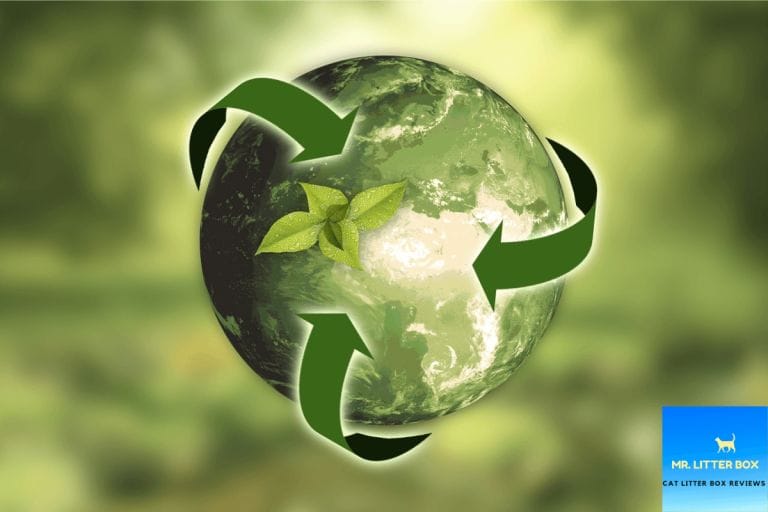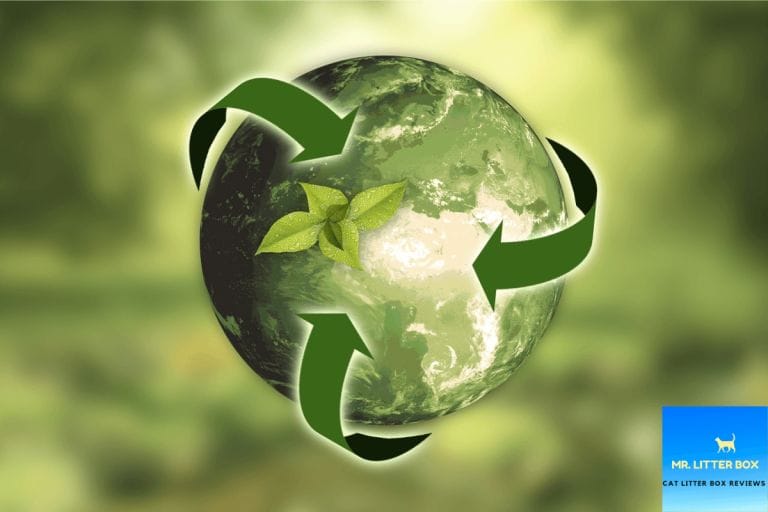Cat litter boxes are essential for every cat owner, but have you ever wondered if they are recyclable?
Unfortunately, most traditional cat litter boxes are made from non-recyclable materials like plastic, which can end up in landfills and contribute to environmental pollution.
However, there are eco-friendly alternatives available in the market that are made from sustainable materials like biodegradable and compostable materials.
These litter boxes offer a more environmentally conscious choice and can be disposed of in an eco-friendly manner.
Let’s discuss the matter in detail…

Understanding the Impact of Traditional Cat Litter Boxes on the Environment
As responsible pet owners, it’s important for us to consider the environmental impact of our furry friends. While we may prioritize their comfort and hygiene, it’s crucial to be mindful of the waste generated by traditional cat litter boxes. In this section, we will delve into the potential environmental consequences associated with these conventional litter boxes.
Economic and Environmental Costs of Clay-based Cat Litter
Traditional cat litter is predominantly made from clay, a non-renewable resource. The extraction and processing of clay for litter production contribute to deforestation and habitat destruction.
Additionally, the transportation of clay-based litters from extraction sites to manufacturing facilities and then to retail stores results in significant carbon emissions, further exacerbating the environmental impact.
Another concern with clay-based litters is their inability to biodegrade. Once used and discarded, they end up in landfills, where they occupy valuable space and release harmful chemicals into the surrounding soil and water systems.
The slow decomposition of clay-based litters contributes to the long-term accumulation of waste, posing a threat to human and environmental health.
Alternatives to Traditional Cat Litter Boxes
Fortunately, there are eco-friendly alternatives to traditional cat litter boxes that minimize their environmental impact while still ensuring your cat’s comfort and hygiene. Let’s explore some of these alternatives:
Biodegradable Cat Litter:
Made from natural materials such as corn, wheat, or recycled paper, biodegradable cat litters offer a sustainable solution. These litters decompose naturally, reducing the amount of waste in landfills. Some biodegradable litters can even be composted, providing an extra environmental benefit.
Silica Gel Crystals:
Silica gel crystal cat litters are made from a form of silica that is highly absorbent. These crystals can hold a significant amount of liquid, reducing the frequency of litter box changes. Silica gel crystals are also non-toxic and environmentally friendly.
Pine Pellets:
Pine pellet cat litters are derived from renewable sources and have excellent odor control properties. These pellets are made from compressed sawdust, which naturally neutralizes odors and can be safely disposed of in compost or garden beds.
Recycled Paper Litter:
Made from recycled paper, these litters are an excellent choice for environmentally conscious pet owners. They are highly absorbent, lightweight, and easy to dispose of as they can be recycled or composted.
Additional Tips for Reducing Environmental Impact
Aside from choosing eco-friendly cat litter alternatives, there are other steps you can take to further minimize the environmental impact of your cat’s waste:
- Consider using flushable cat litter if your plumbing system allows it. This can reduce the amount of waste going to landfills.
- Regularly clean and maintain your cat’s litter box to prevent unnecessary waste buildup and reduce odor.
- Opt for litter boxes made from recycled or sustainable materials.
- Explore options for composting cat waste in a responsible manner.
In summary, traditional cat litter boxes made from clay-based litters have a significant impact on the environment. The extraction, production, and disposal of clay-based litters contribute to deforestation, habitat destruction, carbon emissions, and the accumulation of non-biodegradable waste in landfills.
However, by opting for eco-friendly alternatives and implementing additional environmentally conscious practices, we can mitigate the environmental consequences associated with conventional cat litter boxes.
Let’s prioritize our pets’ well-being while also being stewards of the planet.

Exploring Innovative Recyclable Cat Litter Box Solutions
As responsible pet owners, it is important for us to consider the impact we have on the environment. In this section, we will explore innovative recyclable cat litter box solutions that not only provide a sustainable alternative but also offer convenience and functionality.
1. Biodegradable and Compostable Cat Litter Boxes
One of the most popular alternatives to traditional plastic litter boxes is the use of biodegradable and compostable materials.
These litter boxes are made from natural fibers such as bamboo, corn, or recycled paper, which can break down easily in composting systems.
Not only are they eco-friendly, but they also eliminate the need for plastic disposal, reducing the environmental impact.
Companies like “EcoPaws” and “Beco Pets” have introduced biodegradable cat litter boxes that are not only eco-friendly but also durable and leak-proof. These boxes come in various sizes and designs to suit different cat breeds and households.
2. Recyclable Plastic Cat Litter Boxes
While plastic is generally considered non-biodegradable, some manufacturers have started producing cat litter boxes made from recyclable plastic.
These boxes are designed to be easily disassembled and recycled at the end of their lifespan, minimizing waste and reducing the environmental footprint.
Brands like “Modkat” and “Necoichi” offer recyclable plastic litter boxes that are sturdy, easy to clean, and come with innovative features such as top-entry designs or built-in odor control systems.
These boxes provide a sustainable alternative without compromising on functionality or aesthetics.
3. Self-Cleaning Cat Litter Boxes
Another innovative solution to reduce waste and make litter box maintenance hassle-free is the use of self-cleaning litter boxes.
These automated systems use sensors and mechanisms to detect and remove clumps, keeping the litter clean and odor-free.
Brands like “Litter-Robot” and “CatGenie” offer self-cleaning litter boxes that are not only convenient but also eco-friendly.
These boxes often use biodegradable, flushable litter, and use minimal water or electricity to function.
By eliminating the need for regular scooping and disposal, they reduce waste and provide a hygienic environment for both cats and their owners.
4. Modular and Stackable Cat Litter Boxes
Innovative modular and stackable cat litter boxes offer a space-saving and customizable solution for multi-cat households or limited living spaces. These boxes can be easily stacked or connected, allowing for easy expansion or separation based on the cats’ needs.
Companies like “Catit” and “Petphabet” provide modular litter boxes that can be stacked vertically or side by side, creating a functional and efficient setup.
These boxes often come with additional features such as built-in litter scoops, odor control systems, and privacy hoods, enhancing the overall user experience.
Tips for Responsible Disposal of Non-Recyclable Cat Litter Boxes
When it comes to responsible pet ownership, one important aspect to consider is the proper disposal of non-recyclable cat litter boxes. As cat owners, it is our responsibility to dispose of these waste items in an environmentally conscious manner. In this section, we will discuss some tips to help you dispose of cat litter boxes in a responsible way.
1. Use Biodegradable Litter
Using biodegradable cat litter can significantly reduce your environmental impact. These types of litters are made from natural materials that break down easily over time.
When it’s time to dispose of the litter box, you can simply empty the contents into a compost bin or bury it in your garden, following the guidelines provided by the manufacturer.
2. Double Bagging
If you’re using non-biodegradable cat litter or if your cat has specific litter requirements, double bagging can help contain any odors and prevent leaks.
When disposing of the litter box, place the used litter in a sturdy plastic bag and tie it securely.
Then, place this bag inside another bag to provide an extra layer of protection.
3. Seal the Bag Properly
Ensuring that the bags are properly sealed is crucial to containing any potential odors and preventing leaks.
Use twist ties or zip ties to secure the bags tightly. This will also help prevent any accidental spillage during transportation to the waste disposal site.
4. Check Local Regulations
Before disposing of any non-recyclable cat litter boxes, it’s important to familiarize yourself with the local regulations regarding waste disposal.
Some areas may have specific guidelines or restrictions on how these items should be handled.
You can contact your local municipal waste management department or check their website for more information.
5. Separate from Household Waste
When disposing of non-recyclable cat litter boxes, it is advisable to separate them from your regular household waste.
This will help prevent contamination and ensure proper handling of the waste.
Look for designated collection points or drop-off locations in your area that accept pet waste or hazardous materials.
6. Consider Pet Waste Services
If you find it challenging to dispose of non-recyclable cat litter boxes responsibly on your own, consider utilizing pet waste services.
These services specialize in the proper disposal of pet waste and may offer collection or drop-off options specifically for cat litter boxes.
7. Reusable Litter Boxes
Another option to consider is investing in reusable litter boxes. These boxes are made from durable materials and can be easily cleaned and sanitized after use.
By using reusable litter boxes, you can significantly reduce the amount of waste generated and minimize your environmental impact.
Remember, responsible disposal of non-recyclable cat litter boxes is essential for the well-being of the environment. By following these tips, you can ensure that you are doing your part in minimizing waste and preserving our planet for future generations.
What should I do with used cat litter?
Used cat litter, especially if it’s clumping litter, should be disposed of in the trash. Avoid flushing it down the toilet as it can clog pipes and be harmful to the environment. Place the used litter in a securely tied plastic bag before discarding it.
How often should I clean my cat’s litter box?
It is generally recommended to clean your cat’s litter box at least once a day. Scoop out solid waste and clumps of urine-soaked litter. Fully replace the litter and thoroughly clean the litter box once a week to maintain cleanliness and minimize odors.
Conclusion
In conclusion, while cat litter boxes are not directly recyclable due to their materials, there are alternative ways to be environmentally conscious.
Consider using biodegradable or plant-based cat litter, which can be composted or disposed of in a safe manner.
Additionally, opting for litter boxes made from recycled materials can help reduce waste. Lastly, proper waste management, such as scooping and disposing of litter responsibly, can minimize your environmental impact.
By making these small changes, you can contribute to a more sustainable and eco-friendly approach to cat litter box usage.


